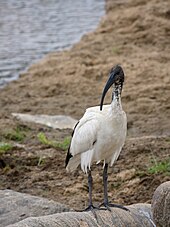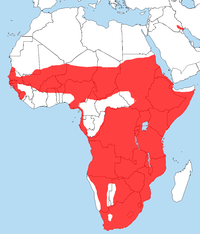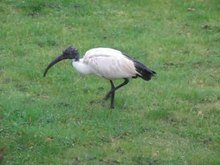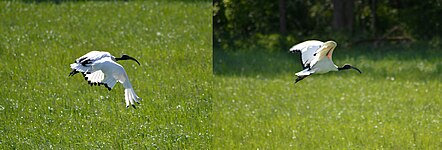Holy ibis
| Holy ibis | ||||||||||
|---|---|---|---|---|---|---|---|---|---|---|

Holy ibis ( Threskiornis aethiopicus ) |
||||||||||
| Systematics | ||||||||||
|
||||||||||
| Scientific name | ||||||||||
| Threskiornis aethiopicus | ||||||||||
| ( Latham , 1790) |

The sacred ibis ( Threskiornis aethiopicus ) is a species of bird from the ibis and spoonbill family (Threskiornithidae) and lives almost exclusively in Africa .
description
The sacred ibis grows to 65 to 75 cm and has a wingspan of 112 to 124 cm. It has largely white plumage with the exception of a few black feathers on the wings. The head is black. Both sexes have the same plumage, males are slightly larger than females.
distribution
Once at home in Egypt , the saint ibis now lives predominantly in sub- Saharan Africa . There are also breeding occurrences in south-eastern Iraq . Its closest relatives are the molucca and black-headed ibis .
The birds mostly live near the water. The population in Egypt, where it was once worshiped as a sacred bird, has now expired.
In France, a population of free-flying animals from the bird park of Branféré in Brittany was established in the 1970s . In 1984 there were around 100 animals, in 1995 around 400 and in 2005 already around 3,000 in a total of 17 departments . It is particularly widespread in the Loire-Atlantique , Vendée and Morbihan ( Pénestin ) departments. But you can also find it on the French Mediterranean coast. Since May 2008, hunters have been shooting down in the Loire-Atlantique department in order to reduce the population because of supposed negative effects on other bird species.
After breeding also occurred in northwestern Italy, specimens have also been sighted in the Po Delta in northeastern Italy. The birds are increasingly being observed in Belgium and the Netherlands , where the first broods have also already occurred. In Germany , prisoner refugees can sometimes be found, possibly also animals from the French population, especially on the Lower Rhine . In 2013, a couple brooded for the first time in Germany, at the Ismaninger reservoir .
In Germany, immediate control of the Holy Ibis is required as soon as it occurs. It is considered an invasive species according to Section 40 of the Federal Nature Conservation Act (BNatSchG), as it can endanger native species. However, a long-term scientific study from 2013 on sacred ibis as neozoa in France comes to the conclusion that the sacred ibis does not endanger any other species.
The saint ibis was included in the “List of Unwanted Species” for the European Union in 2016.
The IUCN estimates that the total population consists of 200,000 to 450,000 animals. The species is classified as "not endangered".
Multiplication
The sacred ibis breeds in colonies. The nest is on the ground, in papyrus thickets, in bushes or in trees. The breeding season of the holy ibises varies depending on the local climatic conditions. 2 to 4 eggs are laid. The brood lasts 28–29 days. When feeding, the young animal grabs the beak of the parent animal with its beak several times, whereupon it chokes out the contents of the gullet for the chick. The young leave the nest after five to six weeks.
food
The sacred ibis is a pronounced food opportunist and feeds on reptiles , fish , crustaceans , large insects , snails and occasionally carrion . Garbage dumps are regularly searched for food. On the coast he can also specialize in eggs and nestlings. So he even z. B. in South Africa had a greater influence on the breeding success of the Cape Shark colonies there than the Dominican gull . The French ibis colonies are now seen as an acute threat, especially for tern colonies .
Others
Sacred ibises usually fly in line or wedge-shaped formations. In ancient Egypt, the holy Ibis was worshiped as the incarnation of the god Thoth . This is where its name comes from. He has often been depicted in artistic works. 1.5 million ibises were buried in the ibis cemeteries in Saqqara , and around four million in the Tuna el-Gebel tomb.
literature
- Bernhard Grzimek (ed.): Grzimeks animal life . 1st edition. tape 7 . Deutscher Taschenbuch Verlag, Frankfurt 1980, ISBN 3-423-03205-7 , pp. 229 ff .
Web links
- Threskiornis aethiopicus in the endangered Red List species the IUCN 2008. Posted by: BirdLife International, 2008. Accessed January 9 of 2009.
- Videos, photos and sound recordings on Threskiornis aethiopicus in the Internet Bird Collection
- http://www.birdingworld.co.uk/images/SacredIbises.pdf (Birdingworld article about the current status of the species in Europe and the identification of the individual subspecies)
- Information on the sacred ibis as an invasive species in Europe DAISIE European Invasive Alien Species Gateway
Individual evidence
- ↑ Ibis sacré: Entre Loire Atlantique et Morbihan, 1,000 to 1,500 oiseaux éradiqués. July 7, 2008, accessed January 25, 2014 (French).
- ↑ Not welcome: the Holy Ibis. In: Stuttgarter Zeitung. December 29, 2013, accessed January 25, 2014 .
- ↑ Klemens Steiof: Action requirements in dealing with non-native and invasive bird species in Germany . In: Reports on bird protection . tape 47/48 , 2011, ISSN 0944-5730 , p. 93-118 .
- ↑ L. Marion: Is the Sacred ibis a real threat to biodiversity? Long-term study of its diet in non-native areas compared to native areas. In: Comptes rendus biologies. Volume 336, Number 4, April 2013, ISSN 1768-3238 , pp. 207-220, doi: 10.1016 / j.crvi.2013.05.001 . PMID 23849724 .
- ↑ List of Invasive Alien Species of Union Concern (PDF) accessed on July 15, 2016.
- ↑ Sally Wasef et al .: Mitogenomic Diversity in Sacred Ibis Mummies sheds light on early Egyptian practices , bioRxiv : 10.1101 / 610584v1 ( Preprint - full text).





